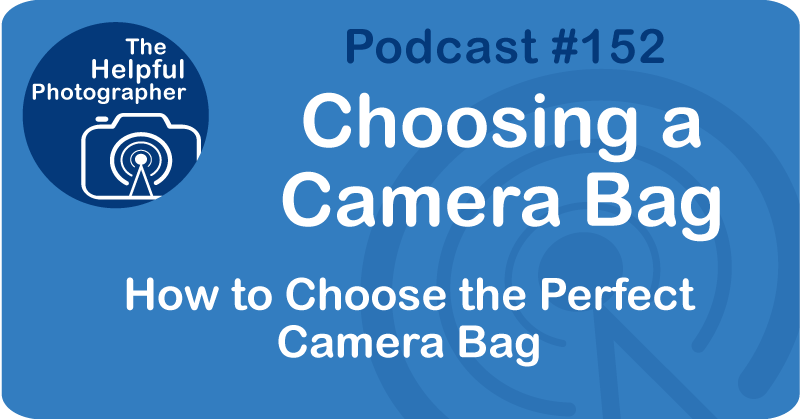Choosing a Camera Bag #152

When it comes to choosing the right camera bag, it's a pretty personal decision. One that's as much about you as it is about the gear you carry. It's not just about functionality, but it's about fit and how you use it. Today, I wanna walk through some of the key things I think everyone should consider when choosing the perfect bag. Let's start by talking about the components that make up a bag. For me, the first and most important factor is weight.
Whether it's my daily backpack, my camera bag, carry-on, or checked luggage, I'm always looking for something lightweight. Many camera bags are surprisingly heavy, even before you put anything inside them. Some weigh 2, 3, or even 4 pounds empty because of unnecessary features like metal parts, or thick, heavy material. Sure, metal clasps and hooks look nice, but plastic ones can be just as sturdy and weigh a lot less. Similarly, some bags use magnets instead of Velcro. While magnets feel fancy and techy, they add weight. And honestly, Velcro gets the job done just fine. Don't get me wrong, I'm not saying they're always bad. There's a time and a place for everything. But it just shouldn't be everywhere in the bag. And I've seen that.
Padding is another thing to consider. A lot of camera bags come with thick padding everywhere. But do you really need that much padding? Unless you're throwing your bag around, probably not. Personally, I prefer light padding just between my gear, not all the way around it. I've even stripped most of the padding from my bag, and it works great for me. The fact is I don't tend to throw my bag around. Less padding means less weight, and your gear will still be well protected if you're careful.
Pockets are another area where it's easy to go overboard. While it's nice to organize your batteries, memory cards, maybe a small notepad, too many pockets can add unnecessary zippers, material, and weight. And again, a lot of these bags are using magnets for that, which means you have an extra flap plus the magnet, which again, weighs down your bag. Now, let's be honest, extra compartments often tempt us to overpack. Keep it simple. Only carry what you need for the day.
As for extra items like chargers, cords, or even your laptop, I recommend keeping those in a separate bag. Camera bags with built-in laptop compartments tend to be bulkier and heavier, and that extra padding is usually overkill. I carry my laptop in a lightweight backpack when I travel, and it works perfectly. Even if you don't carry these things during the day, you are carrying a bigger bag that was built for these extra items.
The material of the bag is another thing to look at. I prefer ripstop nylon because it's lightweight, dries quickly if it gets wet, and durable. Canvas and leather bags might look nice, but they're heavier, and canvas takes longer to dry when wet. And while waterproof bags might sound great, they're rarely necessary unless you're in extreme conditions. And the materials they use are also very heavy.
For most situations, a simple rain cover works just fine. It's lighter and easy to pack. Lastly, there are a couple bags out there made of a material that looks like very heavy vinyl. I personally think these are terrible because they're heavy.
When it comes to bag styles, there are several options. Each has its pros and cons. Let's break them down. The traditional shoulder bag. They're convenient for quick access to your equipment, but tough to carry all day because all the weight sits on your shoulder. Even if you have a long enough strap to wear your bag diagonally across your body, this is still a tough thing to do.
Next up, we have the sling bag. Just like the sling strap, they're designed to go diagonally across your body. They're a step up in terms of comfort because they sit on your back and they can be swung around for easy access, but they still put weight on one shoulder, which can be hard if you're carrying heavier gear.
Then you have the backpack. This is the best option for evenly distributing the weight, especially if they have a waist strap to transfer the load to your hips. However, they're not as convenient for quick and easy access, since you usually have to take them off to get to your gear. Then there's the less popular option, the fanny pack. This is actually my personal favorite for urban and light hiking shoots. I use a Think Tank Speed Freak that combines a waist strap and a shoulder strap for great weight distribution. I can also easily swing my bag to the front to get in and out of my gear quickly. And last but not least, there's the rolling bag. These are great if you're moving equipment over a smooth surface like cement or an airport terminal, but totally impractical for walking and shooting all day or hiking. You cannot get in and out of these bags on the go.
You have to stop and deal with your equipment like you do a backpack. If you're doing a shoot that requires the use of a computer, such as architectural photography or studio shooting, a bag that accommodates a computer is fine. For those who don't need a laptop while shooting, a backpack that accommodates a laptop is usually very heavy. If you plan to carry extras like a tripod or water bottle, check to see whether the bag has attachment points. You can always use straps to customize your system. Pro tip, never carry a water bottle inside your camera bag. Spills can be disastrous. Ask me how I know. Finally, don't fall into the trap of buying a bag that's too big. The more space you have, the more tempted you'll be to overpack. Trust me. Again, ask me how I know. Go for something that fits just what you need for the day and nothing more.
When shopping for a bag, try to test it out. See how it feels on your body with some weight inside. If you're ordering online, consider buying a few options to try at home and return the ones that don't work. Fit is so personal, and what works for someone else might not work for you. And that's why I don't recommend any particular bag. Keep it lightweight, keep it simple, and make sure it feels good when you're carrying it around. I hope this helps you find a bag that fits your gear and your shooting style perfectly. Until next time, keep on shooting.











